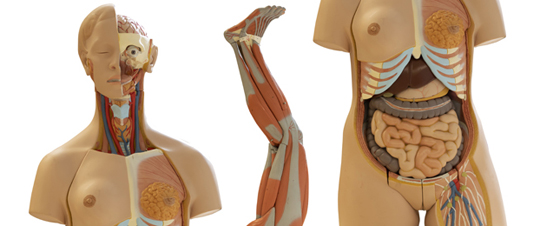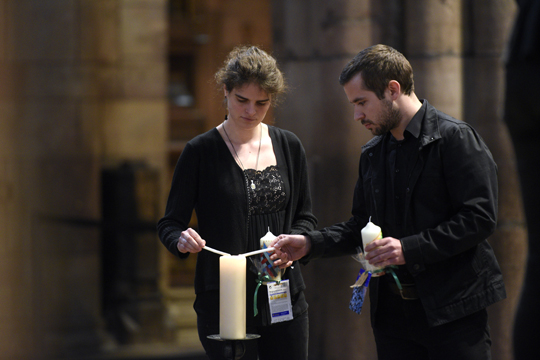Seen from Every Side
Freiburg, Mar 04, 2021
Where are blood vessels located underarm? What does a liver look like? On the University of Freiburg Institute of Anatomy and Cell Biology’s dissection course, students study body structure, the functioning of various body parts, and anatomical variations using real bodies. Ideally, trainee doctors gain practical, hands-on experience, however because of the corona pandemic the institution has had to think up new ideas for the dissection course – support for this comes from across departments.

Anatomical models illustrate the composition and structure of the body, however variations and details have to be studied on a real body. Photos: Jürgen Gocke
Some projects demand lengthy preparation. And still things sometimes turn out differently to how they were planned. Each winter semester, a dissection course for third-semester students of Medicine is held at the University of Freiburg Institute of Anatomy and Cell Biology. This gives them practical insights into the human body at an early stage in their studies. But because of the corona pandemic this course, like others, was threatened with cancellation in the 2020/21 winter semester. “As we were planning over the course of the year we faced two essential challenges: how to hold the dissection course face-to-face, and how to keep it safe for all involved,” says Dr. Stephan Heermann, head of body donation division. In the end, the course took place, using digital teaching methods and following stricter distancing and hygiene rules.
FFP2 masks and fresh air
Roughly 450 students take the dissection course each semester. Until now, up to 24 students divided into two groups were responsible for examining the remains of a donor down to the last detail. Working together with the University of Freiburg’s security department, Heermann and Prof. Dr. Eleni Roussa from the Department of Molecular Embryology came up with a new concept adapting the course to the demanding circumstances of the pandemic. For example, only six students shared responsibility for a donor. Students also alternated mornings and afternoons, to reduce the time they spent in the same room.
Normally up to 100 students would be in the institute’s locker rooms at the same time, preparing for dissection. This had to change given the pandemic. “The institute’s rooms are equipped with one of the best ventilation systems at our university. All the same, the course demands a degree of physical proximity, so we also provided everyone involved with FFP2 masks,” explains Dr. Carsten Kallfaß from the security department. Prof. Dr. Hartmut Hengel, head of the Institute of Virology at the Freiburg University Medical Center, and Dr. Daniel Steinmann, lead university doctor, also provided the team with assistance on making the course as safe as possible. There was positive feedback from the health authority too. “There is no decrease in the quality of our education with the new concept. We’ve had to explain some aspects more often because of the smaller classes, but it’s also meant we’ve interacted better with the students,” emphasizes Heermann.

A gesture of thanks: in the summer semester the students normally organize a memorial service to thank the donors. (Editor’s note: This photograph was taken before the corona pandemic.) Photo: Thomas Kunz
Between the dissection room and ILIAS
In addition Stephan Heermann and his colleagues have increased options with digital, computer-based forms of study such as clinical case studies or dissection videos that the students can view at home via ILIAS. This is an important option, “however it was especially important to us that the students understand the spatial connections on-the-spot and examine organs and other parts of the human body from every side,” explains Heermann.
The strenuous work constantly caused her glasses to steam up with the FFP2 mask, recalls medical student Charlotte Agostini, “We had to change masks regularly. And in order for everything to go smoothly, we had to follow strict rules when changing, fetching utensils and washing hands.” Once everything was ready, ten donor bodies were waiting for their groups in the dissection room. Svenja von Riegen, who also took the course, found working in small groups very agreeable, “Despite the difficult conditions I gained a real idea of the human body and its structure from dissection.” Although she and her fellow students agree that the dissection course was a success, Agostini still missed one aspect a lot, “Suddenly I couldn’t see many of the students that I’d got to know on the first semester.”
A gesture of thanks
Following each dissection course the donor bodies are cremated and during the next summer semester the ashes are buried in urns at the city cemetery. After the funeral, the students organize an ecumenical memorial service at Freiburg Minster, including musical accompaniment. Sadly, the memorial service that was planned for 2020 had to be canceled because of the pandemic, and the next memorial service also cannot take place. “Normally the students would be busy organizing it now and would have produced a choral program,” says Heermann, however he is optimistic, “We’ll definitely hold both events in the future, to express our thanks to the donors and their families.”
Patrick Siegert
LEAD
Anatomical models illustrate the composition and structure of the body, however variations and details have to be studied on a real body.
Photos: Jürgen Gocke
A gesture of thanks: in the summer semester the students normally organize a memorial service to thank the donors. (Editor’s note: This photograph was taken before the corona pandemic.)
Photo: Thomas Kunz

